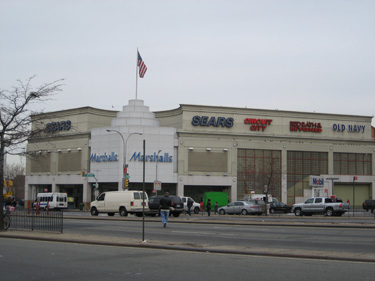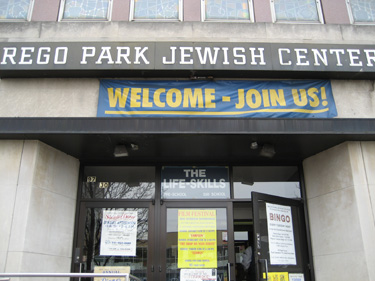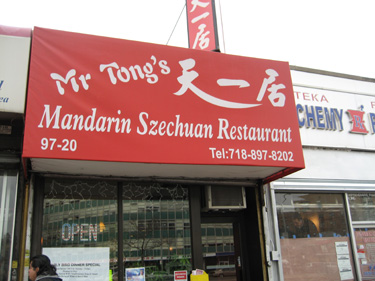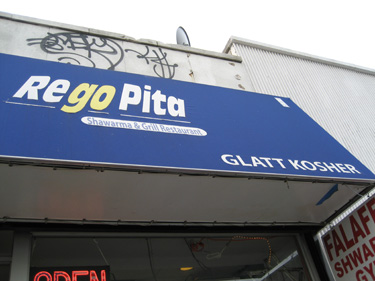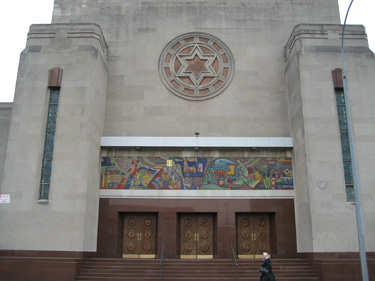Group 3
From Decoding New York
New York City—Glittering Mecca of Rich Diversity and Culture
New York City is globally known as the Mecca of rich diversity and culture. But as one takes a closer look at each of the neighborhoods, which make up this colorful city, it is clear that New York City doesn’t have to be taken as a whole to appear interesting and exciting. Each New York neighborhood brims with an exhilarating history, exotic food, and enticing people, and two such neighborhoods in particular are Rego Park and Washington Heights. At first glance it appears that these two neighborhoods are quite different, however as one delves into each neighborhood’s past and present it becomes obvious that they share many similarities. For instance, Rego Park currently has a predominant Bukharian Jewish population, and Washington Heights, though mostly Dominican in the present, was once home to a significant Jewish population.
Three main “themes” are explored with respect to each of these neighborhoods: “Here Versus There,” “Evolution,” and “Economy.” “Here Versus There” refers to the differences between the neighborhood and the population’s (particularly the immigrant population’s) “mother country.” This encompasses anything from assimilation to the differences in architecture and food between the neighborhood and the population’s birth country. “Evolution” deals with how the neighborhood changes over time and also to what extent the neighborhood’s population tries to hold on to its past. Finally, “Economy” refers to the neighborhood’s shops and stores, and the extent to which the people living in the neighborhood contribute to the economy of their neighborhood in order for it to prosper. Looking at each of these themes with Rego Park and Washington Heights separately will help one to discern any commonality between the two neighborhoods.
Rego Park—An Overview
Rego Park is defined as a neighborhood in the central portion of the New York City borough of Queens. It is bordered to the north by Elmhurst and Corona, the east and south by Forest Hills and the west by Middle Village. Queens is one of the five boroughs of New York City and is geographically the largest borough. It is believed that by the year 2010 the majority of its population will be foreign born.
The vast numbers of Irish and German immigrants that entered the East coast cities during the mid-nineteenth century, engulfed Queens, as well. The Irish who had been displaced by the potato famine, settled in Astoria, and in parts of Jamaica and Flushing. Middle Village, which had been English in the 1840s, became mostly German by 1860. Nowadays, Queens is known for being multiethnic, and is the home of Japanese, Chinese, Koreans, Italians, Puerto Ricans, Greeks, and other groups. The influx of various ethnic groups was helped by immigration acts like the National Immigration Act of 1965.
Although Rego Park is currently known for its great Bukharian Jewish population, other groups are well-represented as well, such as Israeli, Romanian, Iranian, Indian, Colombian, and South Korean groups. Some areas inhabited by large immigrant groups fall prey to crime and poverty, but Rego Park, despite its diverse immigrant community continues to be one of the safer and more “desirable” neighborhoods to live in. Bukharian Jewish immigrants are considered to be Central Asian but because these immigrants come from the former Soviet Union the neighborhood has a certain Russian “aura” to it, as evidenced by the large number of shop signs written in Russian.
Rego Park—“Here Versus There"
Upon entering Rego Park it is clear from the grocery stores, pharmacies, and even clothing stores that the Russian influence on the prevalent Bukharian Jewish population has not waned even in the new country of America. Although, obviously Rego Park and the Russian-speaking mother countries of the residents differ, the immigrants clearly retain their identity through shops and businesses that can offer services in Russian and which can offer them a feeling of security among people who are just like them. It is estimated that about fifty thousand Bukharian Jews immigrated into America in the late twentieth century. Although this is not a large number, in a community like Rego Park this population is dominant. Obviously because these residents now live in America, their initial culture is diluted by customs and traditions of the "American" way of life, which ties into assimilation. It is of course difficult to estimate the extent of assimilation since it is a subjective topic, but it is important to point out that Bukharian Jewish immigrants have had to assimilate twice-once in America, and once in the Soviet Union. After all, Bukharian Jewish immigrants speak Russian, not Bukhori, which is because Russia "homogenized" the culture in the Soviet Union. For instance, Ukrainians don't speak Ukrainian, they speak Russian as a byproduct of the Soviet Union "cultural homogenization" (wanted people to let go of their own religions and languages). It is lucky if even the first generation of Bukharian Jewish immigrants understands Bukhori, as very few of them do. In fact, out of the one-hundred sixty thousand Bukharian Jews in the world, only 37.5% speak Bukhori.
Many Jewish immigrants, including Soviet Jews came over to the United States to get back their culture that the Soviet Union in many ways obliterated. For instance, one anecdote from observing the neighborhood is that there are no McDonald's or Burger King, which can normally be found in almost any neighborhood. But there was a Dunkin' Donuts, which can also be commonly found in many neighborhoods. This discrepancy can be attributed to the fact that the Jewish immigrants keep Kosher and would not appreciate a Burger King or McDonald's in their neighborhood (Meat vs. Dairy). This aspect demonstrates that this community assimilates selectively.
Rego Park fosters a sense of community. Through the Rego Park Jewish Center, men, women, and children are able to communicate with each other and express themselves. However, the Jewish Center is not the only place of cultural contact. According to a young Russian speaking man, “I love working out at the gym here. I stay fit and meet new people. Chinese, Koreans, Indians, the communication’s great and I learn interesting new things, what could be better?!”
On the other hand, when it comes down to seeking employment, many immigrants share their heart wrenching stories of having to start over, “We were doctors there, well respected people, and here, we are nobody” replied one elderly Bukharian woman. On the contrary, where the first generation is failing to obtain a career of their choice, the second generation is succeeding. “My son is a doctor, my daughter is a pharmacist and my second daughter is a lawyer. I love America. It is a very beautiful country,” commented an elderly Bukharian man. Assimilation patterns also differ among other populations that are found in Rego Park. For instance, an Indian couple who have two children demonstrated a certain hostility to the American way of life. When asked whether their children assimilated and became “Americanized,” the mother was quick in her reply, “Never! I raised my children right. They are Indian not American.” Not long afterwards, a mother and her friend were encountered. They, on the contrary, proudly admitted that their children assimilated and are more or less “Americanized.” The views on assimilation greatly differ and ultimately differ. Perhaps this battle against assimilation isn’t necessarily a battle against the American ideal; perhaps it’s a weapon in preserving one’s own culture. To a great extent, this battle of assimilation is what helps to form and maintain ethnic neighborhoods in New York.
Rego Park—“Economy”
Clearly, Rego Park's economy can only be described as flourishing. There are stores that run for blocks on both sides of the street. According to one Bukharian interviewee, “Rego provides me with all I need for my family without having to travel elsewhere.” Indeed, 63rd Drive in Rego Park is the heart of business. From delightful ethnic cuisine to bilingual medical centers (English and Russian), Rego Park has every necessary component of the ideal Bukharian Jewish life in America. And so, the economy of Rego Park is able to thrive and develop due to a strong dominant population of Bukharian Jews who are upholding these businesses because these businesses meet their needs as a people.
The economy of Rego Park is booming especially due to cultural diffusion. According to Tom, the owner of a Chinese Restaurant, “While 60% of my customers are Asians, the other 40% are mixed. Everyone eats here. It’s delicious and authentic! That is why my shop is so successful.” A plethora of other stores contribute to Rego Park’s prosperity; Rego Park Center has an Old Navy, Marshall’s, Circuit City, Sears and Bed Bath & Beyond where many consumers can be found.
Rego Park is easily accessible to all of New York through the E, G, R or V train. This accessibility can also be attributed to the high real estate prices and rising market prices.
Rego Park—“Evolution”
Because Rego Park is predominantly Bukharian Jewish, this ethnic group will be focused on, but other cultures and nationalities, which are present in the neighborhood, also contribute to the changes and “evolution” of the neighborhood as shop workers, owners, and residents. For example, a popular Israeli Falafel restaurant in the neighborhood, "Rego Pita,” which is "glatt kosher," is owned by Moti, an Israeli man who opened his restaurant and has been thriving for fifteen years. Moti points out that even though his restaurant caters to Kosher residents, various ethnic groups, including Korean and Hispanic, enjoy dining at his restaurant. There is a significant population of Mexican residents and there are a number of Mexican workers in the grocery store and pizzeria businesses of Rego Park. “I see the neighborhood changing in the languages spoken and stores that are put up,” said one Mexican resident Jocelyn, 16. Furthermore, there were Bangladeshi/Indian workers in some of the delis. Hence, the "face" of the neighborhood gradually changes as various ethnic groups move out leaving “community niches” for other ethnic groups to fill as they move into the neighborhood.
The more a neighborhood’s population holds on to its past the more “authentic” a neighborhood is in relation to a group’s mother country. Although holding on to one’s “authenticity” may seem to hinder the evolution and change in a neighborhood, in actuality this is not the case since as ethnic groups move in they can contribute a piece of their “authentic heritage.” Slowly but surely the accumulation of various heritages makes a neighborhood evolve into something different. The authenticity of the Jewish culture is largely retained in the neighborhood through the large and beautiful synagogue located centrally in Rego Park. “We try to retain the teachings of our Judaic heritage so that the future generations can experience it in its actual form, not as something that gets changed around as the years go by,” explained the Rabbi of the synagogue. The synagogue is not just a place of religious worship but also a facilitator of community gatherings. For example, the "Jewish Sisterhood" sponsored by the synagogue, unites Jewish women of the community and teaches them about their faith. There are even singles dances and tutoring services for children sponsored by the synagogue.
A Comparison— Washington Heights and Rego Park
Some may believe that two neighborhoods like Rego Park and Washington Heights couldn’t possibly have anything in common. After all, the differences are abundant. For instance, Rego Park is composed of primarily Bukharian Jews, whereas Washington Heights has a predominantly Christian Hispanic population. Furthermore, these two groups not only come from different areas of the globe but have what appear to be completely dissimilar histories. Yet if one takes the time to really look closely into the two groups’ experiences in the United States, it becomes clear that they have more in common than initially thought. In fact, many immigrant groups can relate to one another because of the hardships, isolations, and also triumphs that immigrants have to face as they settle in the United States.
Although Washington Heights is currently considered a Hispanic neighborhood, it was at one time an area which was populated by a significant number of Soviet Jews who made the neighborhood their own through Georgian restaurants and shop signs written in Russian. Similarly, the Bukharian Jews residing presently in Rego Park make the neighborhood their own through Soviet influence on the neighborhood’s landscape and ambience. Both neighborhoods also at one point were home to countless Irish settlers in the early twentieth century.
When immigrants first arrive in the United States they lack the security and familiarity of their homeland. Thus to counteract the unbearable feelings of loneliness and hopelessness, immigrants from the same country or region “ban together” in neighborhoods where they can speak their native language and be offered helpful services from people who understand their language and culture—such is the case with the residents of Rego Park and Washington Heights. Hispanic residents of Washington Heights hold on to their roots from places like the Dominican Republic, Puerto Rico, and Mexico by the many small shops with sign names in Spanish, and Hispanic-centered cuisine. The Bukharian Jewish population of Rego Park also maintains its Soviet identity—albeit this is an identity that isn’t exactly its own but was in many ways forced upon it—through the many Russian grocery stores, Bukharian restuarants, and store signs which may be entirely in Russian or may offer a combination of English and Russian writing.
The economies of both neighborhoods flourish in roughly the same way—through blocks upon blocks of small businesses catering to each population. Interestingly, one particular area of business that flourishes in both neighborhoods is ethnic fashion. Though one cannot say that Washington Heights stores like “Juanito Fashion,” which offer urban-centered fashion, cater to individuals who want traditional Hispanic dress, shops like these that offer clothing styles which many Hispanics adhere to, do support Hispanic culture. Likewise, in Rego Park, one or two shops were found that provide residents with the opportunity to buy traditional Bukharian dress for men and women.
And so, when one first takes a look at two different places it may seem impossible to compare two groups of people with unrelated languges, customs, and beliefs. However, as one explores beneath people’s unique superficial differences, what becomes apparent is that we are all alike in terms of our wish to survive and persevere wherever we may end up settling and living.
Sources—Rego Park and Washington Heights
http://www.washington-heights.us/
Jackson, Kenneth T.ed. Encyclopedia of New York City. New Haven: Yale University Press, 1995.
2005 American Community Survey Fact Sheet for Queens County, New York, United States Census Bureau.
Burrows, Edwin G. and Mike Wallace.Gotham: A History of New York City to 1898. Oxford University Press, 1998.
http://www.house.gov/weiner/neighborhoods/hoods_regopark.htm, 1995.
Foner, Nancy. New Immigrants In New York. New York: Columbia University Press, 111-138.
Bukharian Woman, Rego Park Resident. Interviewed by Karina Fatova, Irina Mullokandova, and Quinn Marston, February 2007, New York. “Sidewalk” interview.
Bukharian Man, Rego Park Resident. Interviewed by Karina Fatova, Irina Mullokandova, and Quinn Marston, February 2007, New York. “Sidewalk” interview.
Indian Couple, Rego Park Residents. Interviewed by Karina Fatova, Irina Mullokandova, and Quinn Marston, February 2007, New York. “Sidewalk” interview.
Indian Women, Rego Park Residents. Interviewed by Karina Fatova, Irina Mullokandova, and Quinn Marston, February 2007, New York. “Sidewalk” interview.
Tom, Chinese Restaurant Owner. Interviewed by Karina Fatova, Irina Mullokandova, and Quinn Marston, February 2007, New York. “Sit-down” interview.
Hababa, Mordchai, Israeli Restaurant Owner. Interviewed by Karina Fatova, Irina Mullokandova, and Quinn Marston, February 2007, New York. “Sit-down” interview.
Jocelyn, Rego Park Resident. Interviewed by Karina Fatova, Irina Mullokandova, and Quinn Marston, February 2007, New York. “Sidewalk” interview.
Rabbi. Interviewed by Karina Fatova, Irina Mullokandova, and Quinn Marston, February 2007, New York. “Sit-down” interview.
Rego Park- "Neighborhood in the central portion of the New York City borough of Queens. It is bordered to the north by Elmhurst and Corona, the east and south by Forest Hills and the west by Middle Village."
1. "Here vs. There"
Upon entering Rego Park it is clear from the grocery stores, pharmacies, and even clothing stores that the Russian influence on the prevalent Bukharian Jewish population has not waned even in the new country of America. Although, obviously Rego Park and the Russian-speaking mother countries of the residents differ, the immigrants clearly retain their identity through shops and businesses that can offer services in Russian and which can offer them a feeling of security among people who are just like them. It is estimated that about fifty thousand Bukharian Jews immigrated into America in the late twentieth century. Although this is not a large number, in a community like Rego Park this population is dominant. Obviously because these residents now live in America, their initial culture is diluted by customs and traditions of the "American" way of life, which ties into assimilation. It is of course difficult to estimate the extent of assimilation since it is a subjective topic, but it is important to point out that Bukharian Jewish immigrants have had to assimilate twice-once in America, and once in the Soviet Union. After all, Bukharian Jewish immigrants speak Russian, not Bukhori, which is because Russia "homogenized" the culture in the Soviet Union. For instance, Ukrainians don't speak Ukrainian, they speak Russian as a byproduct of the Soviet Union "cultural homogenization" (wanted people to let go of their own religions and languages). It is lucky if even the first generation of Bukharian Jewish immigrants understands Bukhori, as very few of them do. In fact, out of the one-hundred sixty thousand Bukharian Jews in the world, only 37.5% speak Bukhori. (Note: In class, when we were discussing Nancy Foner's New Immigrants, we noted how many Jewish immigrants, including Soviet Jews came over to get their culture back that the Soviet Union in many ways obliterated. For instance, one anecdote from observing the neighborhood is that there are no McDonald's or Burger King, which can be normally found in almost any neighborhood. But there was a Dunkin' Donuts, which can also be commonly found in many neighborhoods. We attributed this discrepancy to the fact that the Jewish immigrants keep Kosher and would not appreciate a Burger King or McDonald's in their neighborhood.)
2. "Evolution"
Although Rego Park is known for its Bukharian Jewish dominant population, other cultures and nationalities are moving in as well, as shop workers and owners, and even residents. For example, there was a popular Israeli Falafel restaurant in the neighborhood, "Rego Pita,"which is "glatt kosher" and owned by, Moti, an Israeli man who opened his restuarant and has been thriving for fifteen years. We also interviewed a significant number of Mexican residents, and there were a number of Mexican workers observed in the grocery stores and pizzerias of Rego Park. Furthermore, there were Bangladeshi/Indian workers in some of the delis. Hence, the "face" of the neighborhood is gradually changing.
3. "What's Real"
The authenticity of the Jewish culture is largely retained in the neighborhood through the large and beautiful synagogue located centrally in Rego Park. (Note: We waited quite some time to speak to the Rabbi but he was unable to due to some schedule conflict.) Furthermore, as "outsiders" looking into the neighborhood, we realized that the synagogue is not just a place of religious worship but also a facilitator of community gatherings. For example, there was the "Jewish Sisterhood" sponsored by the synagogue, which united Jewish women of the community and taught them about their faith. There are even singles dances and tutoring services for children sponsored by the synagogue.
4. "Economy"
Clearly, Rego Park's economy can only be described as flourishing. There are stores that run continously for blocks upon blocks on both sides of the street. From delightful ethnic cusine to bilingual medical centers (English and Russian), Rego Park has every necessary component of the ideal Bukharian Jewish life in America. And so, the economy of Rego Park is able to thrive and develop due to a strong dominant population of Bukharian Jews who are upholding these businesses because these businesses meet their needs as a people.
Possible Suggestions and Ideas
-We feel that while longer, more intimate/detailed interviews would serve a greater purpose and provide a better understanding of the interviewee’s experience as well as provide a better generalized idea about immigration, assimilation and all other related matters, the reality is quite different. Due to our prior experience at Rego Park and Forest Hills where besides getting visual images and trying to grasp an understanding of the people there, we spent a great deal interviewing people voluntarily. We interviewed many people including residents, shoppers, and store/business/restaurant owners. One important thing that we noted was that many people are not willing to sit down for a long conversation; many people aren’t even willing to spare a moment. Shoppers and residents are rushing to their destination point and owners are busy trying to please their customers. They have no time to entertain college students who aren’t going to benefit them in anyway. Thus, we feel that a few questions from many people would be best. A nice percentage can be taken from all those interviewed. Some particular questions that we found effective in helping to learn about the interviewee are written below.
-Interviewee’s name to establish some sense of intimacy
-Do you live here? What do you think about this place?
-What populations do you see in this neighborhood the most and/or what ethnicities and nationalities are many of the customers?
-Do you like living here?
-Where were you born?
-How do you feel about immigration?
-Are you a citizen? Or do you intend on getting your citizenship?
-How do you feel about New York? What do you enjoy most about it?
-Do you feel that you’ve completely become Americanized?
-Do you think that it is important to preserve your roots/culture?
-Also, towards the end, we realized that many people were slightly unwilling to be interviewed because they were intimidated and maybe afraid. While we did explain that we were students from Hunter College and we were doing an immigration studies project, we realized that it be best to introduce ourselves by our first names and make everyone’s experience a little more personalized. With regards to Rego Park and Forest Hills, we were able to get many detailed interviews. Interestingly, many of these interviews were done in Russian as a way to reduce the language barrier and not only allow people to understand the questions presented to them but also answer in a way that doesn’t limit their thoughts or ideas.
-Another very important suggestion that we came up with is that when the questions are being asked, and when we are presenting ourselves to the interviewee, the relationship must be professional. This means that when introducing oneself, it is important not to laugh or do anything that makes the interviewee feel uncomfortable or makes the interview seem like a joke.
-We also feel that taking pictures is very essential. Pictures should not only be taken of stores and buildings but of the actual people that live and shop there. Maps can be easily obtained from reputable online sources that will also help navigate our study more precisely. Captions are an integral part of pictures and we will use a combination of identifying the image, providing substantial information and even posing a question. While photographs are not always aspects of reality, they do provide a visual clue as to how a neighborhood functions.
Topic: Rego Park and Washington Heights Outline: Topics
I. An overview of the geographic and social climate of Rego Park
II. An overview of the geographic and social climate of Washington Heights
III. A comparison between the two neighborhoods in terms of gentrification, stereotypes, influence of immigration, and the levels of assimilation in each community.
IV. Contrast between the two neighborhoods in terms of gentrification, stereotypes, influence of immigration, and the levels of assimilation in each community.
V. Find an overarching theme that unifies the two neighborhoods despite their many differences.
Washington Heights Sources
1. http://www.washington-heights.us/
2. http://www.nycfoto.com/showPage.php?albumID=807
3. Dominican-Americans and the politics of empowerment / Ana Aparicio. By Aparicio, Ana, Gainesvillle : University Press of Florida, c2006.
4. HEADLINE: Inspired by NYC neighborhood, 'In the Heights' bounces from salsa to hip-hop to show tunes BYLINE: By TIM MOLLOY, Associated Press Writer DATELINE: NEW YORK
5. HEADLINE: A day in Latin New York: Un dia en Nueva York BYLINE: By BETH J. HARPAZ, AP Travel Editor DATELINE: NEW YORK
6. HEADLINE: Tenants Ordered Out of Damaged Washington Hts. Building BYLINE: By THOMAS J. LUECK; Colin Moynihan contributed reporting.
7. Our Public Schools.; INDIGNATION MEETING OF THE CITIZENS IN REFERENCE TO APPOINTMENT OF PRINCIPAL OF GRAMMAR SCHOOL NO. 46 AT WASHINGTON HEIGHTS. New York Times (1857-Current file). New York, N.Y.: Mar 13, 1864. p. 8 (1 page)
Rego Park Sources
1. HEADLINE: HEY ... LEAVE THOSE KIDS ALONE! PARENTS RIP EFFORT TO BRING OLDER STUDENTS INTO REGO PARK SCHOOL BYLINE: BY NICHOLAS HIRSHON DAILY NEWS STAFF WRITER
2. HEADLINE: POLS URGED TO HELP SHUT 'SEX' MOTEL BYLINE: BY NICHOLAS HIRSHON DAILY NEWS WRITER
3. HEADLINE: Na Zdorovje! Gothamist goes to Vostok
4. HEADLINE: CELEBRATING LIFE AND FAMILY BYLINE: BY DEREK ROSE
5. http://www.bjews.com/ [[Image:File:Example.jpg[[Image:File:Example.jpg]]]] [link title[link title[link title]]]
